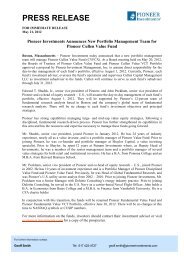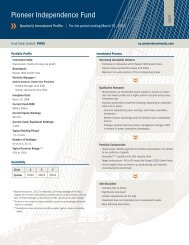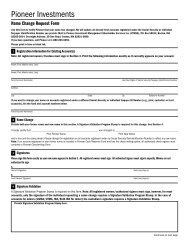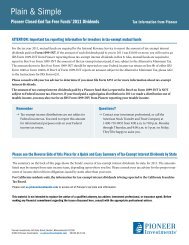Pioneer PRISM XC Variable Annuity - Pioneer Investments
Pioneer PRISM XC Variable Annuity - Pioneer Investments
Pioneer PRISM XC Variable Annuity - Pioneer Investments
Create successful ePaper yourself
Turn your PDF publications into a flip-book with our unique Google optimized e-Paper software.
Program. If you participate in the Automatic Rebalancing<br />
Program, the transfers made under the program are not<br />
taken into account in determining any transfer fee.<br />
Example:<br />
Assume that you want your initial purchase payment split<br />
between 2 investment portfolios. You want 40% to be in<br />
the <strong>Pioneer</strong> Bond VCT Portfolio and 60% to be in the Legg<br />
Mason Partners <strong>Variable</strong> Aggressive Portfolio. Over the<br />
next 2 1/2 months the bond market does very well while<br />
the stock market performs poorly. At the end of the first<br />
quarter, the <strong>Pioneer</strong> Bond VCT Portfolio now represents<br />
50% of your holdings because of its increase in value. If<br />
you have chosen to have your holdings rebalanced<br />
quarterly, on the first day of the next quarter, we will sell<br />
some of your units in the <strong>Pioneer</strong> Bond VCT Portfolio to<br />
bring its value back to 40% and use the money to buy<br />
more units in the Legg Mason Partners <strong>Variable</strong> Aggressive<br />
Portfolio to increase those holdings to 60%.<br />
Voting Rights<br />
We are the legal owner of the investment portfolio shares.<br />
However, we believe that when an investment portfolio<br />
solicits proxies in conjunction with a vote of shareholders,<br />
we are required to obtain from you and other affected<br />
owners instructions as to how to vote those shares. When<br />
we receive those instructions, we will vote all of the shares<br />
we own in proportion to those instructions. This will also<br />
include any shares that we own on our own behalf. The<br />
effect of this proportional voting is that a small number of<br />
contract owners may control the outcome of a vote. Should<br />
we determine that we are no longer required to comply<br />
with the above, we will vote the shares in our own right.<br />
Substitution of Investment Options<br />
If investment in the investment portfolios or a particular<br />
investment portfolio is no longer possible, in our judgment<br />
becomes inappropriate for purposes of the contract, or for<br />
any other reason in our sole discretion, we may substitute<br />
another investment portfolio or investment portfolios<br />
without your consent. The substituted investment portfolio<br />
may have different fees and expenses. Substitution may be<br />
made with respect to existing investments or the investment<br />
of future purchase payments, or both. However, we will<br />
not make such substitution without any necessary approval<br />
of the Securities and Exchange Commission and applicable<br />
state insurance departments. Furthermore, we may close<br />
investment portfolios to allocation of purchase payments or<br />
account value, or both, at any time in our sole discretion.<br />
4. EXPENSES<br />
There are charges and other expenses associated with the<br />
contract that reduce the return on your investment in the<br />
contract. These charges and expenses are:<br />
Product Charges<br />
Separate Account Product Charges. Each day, we<br />
make a deduction for our Separate Account product<br />
charges (which consist of the mortality and expense charge,<br />
the administration charge and the charge related to a death<br />
benefit rider). We do this as part of our calculation of the<br />
value of the accumulation units and the annuity units (i.e.,<br />
during the accumulation phase and the income phase—<br />
although death benefit charges no longer continue in the<br />
income phase).<br />
Mortality and Expense Charge. We assess a daily<br />
mortality and expense charge that is equal, on an annual<br />
basis, to 1.40% of the average daily net asset value of each<br />
investment portfolio.<br />
This charge compensates us for mortality risks we assume<br />
for the annuity payment and death benefit guarantees made<br />
under the contract. These guarantees include making<br />
annuity payments that will not change based on our actual<br />
mortality experience, and providing a guaranteed minimum<br />
death benefit under the contract. The charge also<br />
compensates us for expense risks we assume to cover<br />
contract maintenance expenses. These expenses may<br />
include issuing contracts, maintaining records, making and<br />
maintaining subaccounts available under the contract and<br />
performing accounting, regulatory compliance, and<br />
reporting functions. This charge also compensates us for<br />
costs associated with the establishment and administration<br />
of the contract, including programs like transfers and<br />
dollar cost averaging. If the mortality and expense charge is<br />
inadequate to cover the actual expenses of mortality,<br />
maintenance, and administration, we will bear the loss. If<br />
the charge exceeds the actual expenses, we will add the<br />
excess to our profit and it may be used to finance<br />
distribution expenses or for any other purpose.<br />
Administration Charge. This charge is equal, on an<br />
annual basis, to 0.25% of the average daily net asset value<br />
of each investment portfolio. This charge, together with the<br />
account fee (see below), is for the expenses associated with<br />
the administration of the contract. Some of these expenses<br />
are: issuing contracts, maintaining records, providing<br />
accounting, valuation, regulatory and reporting services, as<br />
28













